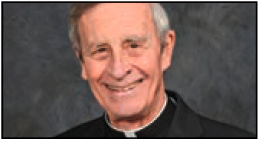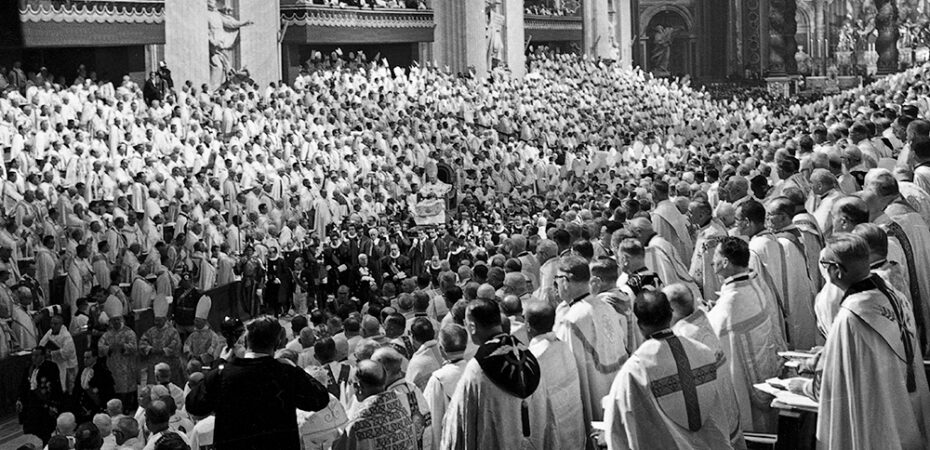The Second Vatican Council
Its implementation brought new hope, yet turmoil, into the Church
Father Robert J. Hater Comments Off on The Second Vatican Council
 Pope Pius XII directed the Church through World War II. He was a traditionalist, and the education that we priests received in the seminary during his reign centered on scholastic theology.
Pope Pius XII directed the Church through World War II. He was a traditionalist, and the education that we priests received in the seminary during his reign centered on scholastic theology.
After he died, Cardinal Angelo Roncalli, the 76-year-old patriarch of Venice, Italy, replaced him. This much-loved, jovial man was initially seen as an intermediate pope — a moderate in thought, and unlikely to make any theological waves. Little did the cardinals who elected him realize the direction he would take the Church. When elected pontiff, he selected the name John XXIII.
Not long after he became pope, it became clear that he did not go along with the dictates of the ultraconservative Roman Curia. This simple, agrarian man, who cherished life, surprised the world when he announced the calling, on Jan. 25, 1959, of an ecumenical council, the first since Vatican I, which was 100 years prior. Even though his tenure as pope was only four years and seven months, it was very significant, for it ended the Tridentine era and issued new and sometimes radical directions for the Church.
Second Vatican Council
I was in my final year of theology when the council was announced. At first, there was little stir at the seminary, for we were unclear about what would happen next.
At this time, the period after World War II and the Korean War, the Church was ripe for change, and tensions had surfaced from those eager to shift the Church’s focus and bring it into the 20th century, rather than maintain its fortress mentality.
The world was entering a new era, influenced by fresh technological and cultural movements that would lead to greater awareness of inequalities in the world, illustrated by the Civil Rights Movement in the United States and by new directions in theology that previous popes kept under wraps. Initially, the Curia prepared the tone and tenor of the first session of the council, which they presumed would be used by the bishops.
On Oct. 16, 1962, with the splendor of a Vatican celebration, the council began. After the first day, Pope John XXIII addressed the whole body of bishops with moving words, not in keeping with the proposals of the Curia. With his inspiration, the assembly of bishops changed directions, thus breaking the hold of the Curia.
When John XXIII died on June 3, 1963, the world held its breath, wondering what would happen at the council. Giovanni Battista Montini was elected the new pope. This progressive thinker, an academic man, with a keen intellect and good organizational skills, took the name of Paul VI.
The newly elected pope opened the second session of the council, following in the footsteps of his predecessor. During the final two sessions, the council fathers produced some of the most remarkable documents in Church history. They set a new direction for the Church in the modern world. The council officially ended Dec. 8, 1965.
My Reflections
Several years after the council began, the Church started to realize the full implications of Vatican II. Its implementation brought new hope, yet turmoil, into the Church as opposition between traditionalists and new-age Catholics intensified. I saw this firsthand in my teaching, parish work and when pursuing a doctoral degree in New York.
On the traditional side, the Baltimore Catechism began to fade from use. In contrast, on the more progressive side, changes, often of an experimental kind, surfaced in some parishes and elsewhere by well-meaning priests and other Church members.
The new directives of Vatican II created splits in the Church, and opposition between some members of the clergy was strong. This was evidenced at a clergy meeting in New York. Two older priests became upset when the speaker told the assembly that lay people would soon be reading at Mass. As he said this, one priest turned to those around him and said, “I’ll never allow a layperson in my sanctuary.”
In contrast, at another Sunday gathering for Mass in a private residence, a group of energetic post-Vatican II advocates attended a Mass, celebrated by a priest, who made up his own Eucharistic prayer. Between these two extremes, a whole range of differences existed as to what was happening in the Church.
The average Catholic went along with what the bishops proposed, while confusion, unrest and defections occurred in this troublesome period of Church history. Most Catholics knew the changes in Church procedures and the new way of thinking were significant, and many became excited at the new possibilities.
The clergy were often as much in the dark as anyone else. After the council, new pastoral approaches were tried with varying degrees of success. Directives came from the bishops and post-Vatican II theology often replaced the teachings of St. Thomas Aquinas. Theologians were in demand, to explain in diocesan assemblies and national conventions the new directives coming from the council’s teachings. Catholics were hungry for what was happening, especially the “newest” things in the Church. Often, when it became known that a leading theologian would lecture on Vatican II, auditoriums and convention centers were filled with attendees.
In the 1960s, the unrest that affected secular society by the way of change also entered the Church at the same time that Vatican II was taking place and began to be implemented worldwide.
The Church was no longer a quasi-closed society, previously referred to as having a fortress mentality, but one committed to openness to the world, society and ecumenical groups. It entered a new era precisely at the time when its presence was most needed.
FATHER ROBERT J. HATER, Ph.D., a Cincinnati archdiocesan priest, is an internationally known author and lecturer. He is professor emeritus at the University of Dayton and resides at St. Clare Parish in Cincinnati.





